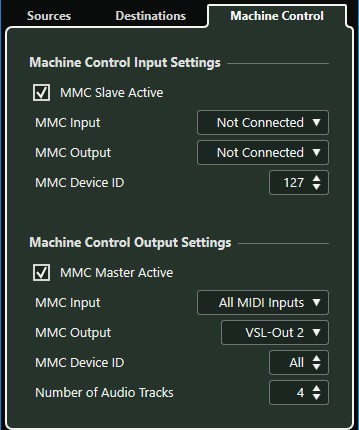Machine Control Page

Machine Control Input Settings
These settings become available, if you select MIDI Machine Control as machine control input. In the Machine Control Input Settings section, you can set up Cubase to follow incoming transport commands and to respond to record-enabling commands for audio tracks. This allows Cubase to integrate into larger studio systems with centralized machine control and synchronization such as theatrical mixing stages.
The following options are available:
- MMC Input
-
Allows you to select the MIDI input that is connected to the master machine control device.
- MMC Output
-
Allows you to select the MIDI output that is connected to the master machine control device.
- MMC Device ID
-
Determines the MIDI ID that is used to identify the machine in Cubase.
The MMC protocol involves polling devices for their status, which requires a 2-way communication. Therefore, we recommend that you connect both the MIDI input and MIDI output port of MMC devices.
Machine Control Output Settings
In the Machine Control Output Settings section, the following options are available:
- MMC Master Active
-
Routes transport commands to any device while sync is enabled.
- MMC Input
-
Determines which MIDI port in your system receives MMC commands. Set this to a MIDI port that is connected to the desired MIDI device.
- MMC Output
-
Determines which MIDI port in your system sends MMC commands. Set this to a MIDI port that is connected to the desired MIDI device.
- MMC Device ID
-
Set this to the same device ID as in the Machine Control Input Settings section.
NoteIf more than one machine is receiving MMC commands or if you do not know the device ID, you can set the ID to All. However, devices that can only listen to their specific IDs do not work if the ID is set to All.
- Number of Audio Tracks
-
Determines how many record-enable buttons are shown in the MMC Master Panel. Set this to the number of available audio tracks in the destination device.